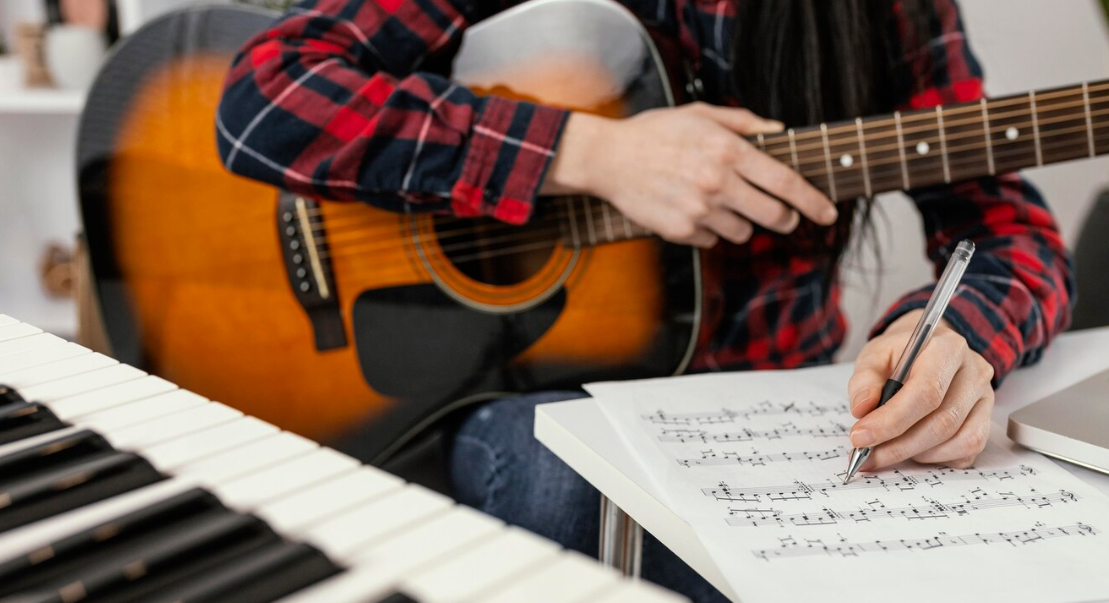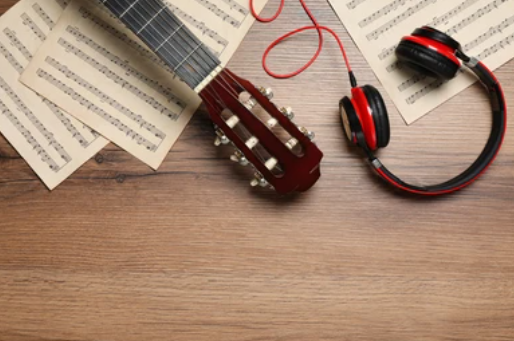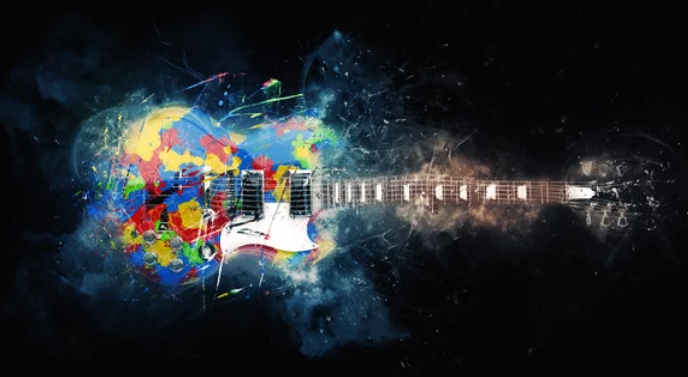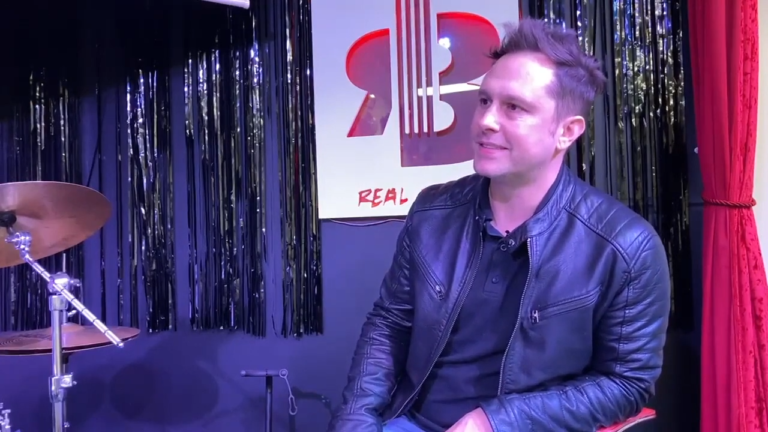The Amazing Sound of the G Power Chord
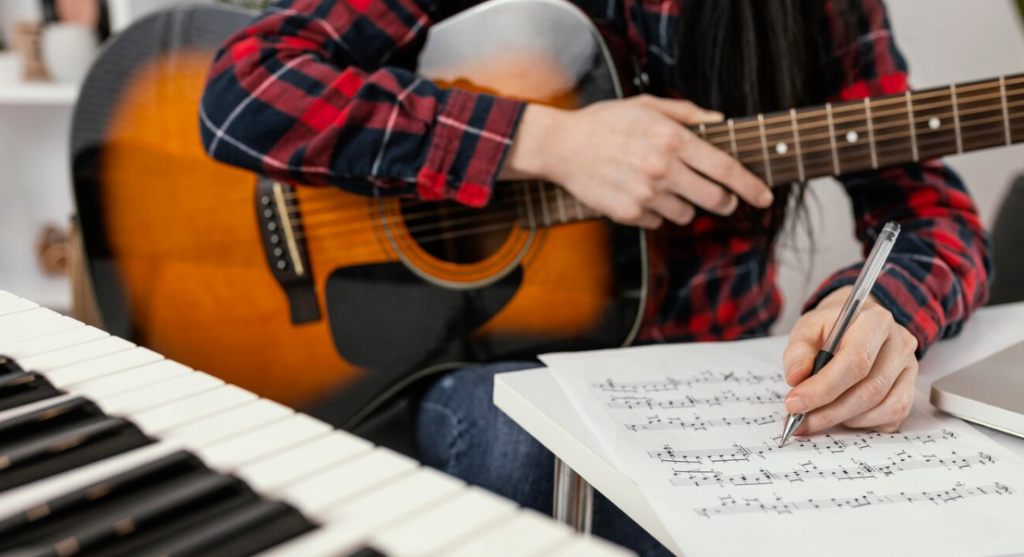
At Real Brave, we guarantee progress in learning and here is a comprehensive guide that focuses exclusively on guitar. We will focus on the G Power Chord. If you want more, please email me dan@realbraveaudio.com otherwise this will be way too long! Who has the attention span for that?
Understanding the Power Chord
Guitar players, Assemble! Certain chords form the backbone of numerous songs across various genres and the G Power Chord is personally one of the most used I have seen out there. Among these, this power chord holds a special place, especially in rock, punk, and metal music. Power chords are simplified chords that deliver a raw, powerful sound, which is why they are a staple in music that requires a strong, driving rhythm. Probably because it’s on the third fret- right there with most of the beginner chords.
What is a Power Chord?
A power chord, technically known as a “fifth chord,” typically consists of two notes the root note and the fifth note of the scale- even the octave. These chords are neither major nor minor, which gives them a versatile and neutral sound, perfect for various musical styles. Power chords are usually played on electric guitars with distortion, which emphasizes their aggressive tone. However, they can also be effectively played on acoustic guitars, offering a rich, resonant sound. Rock on below.
The G Power Chord A Key Player
The G Power chord is easy to play and is on the third fret. Doesn’t sound too shabby either! It’s often one of the first chords beginners learn due to its relative ease of playing and its frequent appearance in popular songs. Mastering the G Power Chord not only provides a solid foundation for playing more complex chords but also opens up a vast repertoire of songs for beginners.
Why Focus on the G Power Chord?
The G Power Chord is fundamental for several reasons
Ease of Learning
- It involves a really easy finger placement, making it an excellent starting point for beginners.
Versatility
- This chord can be used in a variety of musical genres, from the mellow strumming of acoustic ballads to the high-energy riffs of rock music.
Building Confidence
- Mastering this chord early on can boost a beginner’s confidence, encouraging further exploration and learning in guitar playing.
What Will This Article Cover?
Ok, Chief.
This piece is designed as a comprehensive guide to understanding and perfecting the G Power Chord. We will begin with a fundamental overview of the guitar’s structure and incrementally advance to the intricacies of executing this specific chord. You will gain insights into correct finger placement, strumming methods, common pitfalls to sidestep, and effective practice strategies. By the time you finish this article, your grasp of the G Power Chord will extend beyond merely playing it, to understanding its significance in music composition. Let’s get started!
Understanding the Basics
Before diving into the specifics of the G Power Chord, it’s essential to familiarize yourself with some basic concepts and terminologies related to guitar playing. This foundational knowledge will help you grasp the chord-playing techniques more effectively.
Understanding Guitar Anatomy
- Fretboard: The long, thin part of the guitar where you press the strings to create different notes. The fretboard is divided into sections called frets.
- Frets:These are the metal strips that run across the fretboard. When you press a string down behind a fret, it changes the pitch of the string.
- Strings: Guitars typically have six strings. They are numbered from 1 to 6, with 1 being the thinnest and highest-pitched string, and 6 being the thickest and lowest-pitched string.
- Nut: This is the small bar at the top of the fretboard that the strings rest on.
- Bridge: Located on the body of the guitar, the bridge anchors the strings and helps transmit vibrations to the soundboard.
What are Power Chords?
Power chords are a type of guitar chord that uses only two or three notes and omits the third interval, which determines whether a chord is major or minor. This gives power chords a neutral, open sound that can fit into many musical contexts. They are often played with distortion in electric guitar music for a thick, powerful sound.
Finger Positioning and Hand Ergonomics
When playing chords, including power chords, proper finger positioning is crucial. Here are some general tips for beginners
- Thumb Position: Your thumb should rest at the back of the guitar neck, roughly opposite your second or third finger.
- Finger Placement: Press the strings with the tips of your fingers, not the pads. Make sure your fingers are as close to the frets as possible without being on top of them.
- Hand Shape: Your fingers should be curved, and your hand should form a sort of ‘C’ shape. Avoid flattening your fingers.
- Pressure: Apply enough pressure to avoid buzzing sounds, but not so much that it causes discomfort.
Importance of Hand Ergonomics
Playing guitar, especially for extended periods, can strain your hands and wrists. Here are some ergonomic principles to keep in mind
- Keep your wrist relatively straight. Extreme bending can lead to discomfort and injury.
- Relax your shoulders and arms. Tension can lead to poor technique and injury.
- Adjust your guitar position and strap height for comfort and accessibility to the fretboard.
Getting to Know the G Power Chord
The Structure of the G Power Chord
The G Power Chord, often denoted as G5, consists of two primary notes G (the root note) and D (the fifth note in the G major scale). In standard guitar tuning, this chord is typically played using the 6th (E) and 5th (A) strings.
Finger Placement for the G Power Chord
1. Positioning Your Fingers
- Place your index finger on the 3rd fret of the 6th string. This is the G note.
- Place your ring finger on the 5th fret of the 5th string. This is the D note.
2. Ensuring Clear Sound
3. Press firmly on the strings with the tips of your fingers
- Make sure your fingers are not touching adjacent strings, as this can mute them or create unwanted noise.
4. Strumming the Chord
- Strum only the two strings you are pressing (the 6th and 5th strings). Avoid strumming other strings to maintain the clarity of the power chord.
Visual Aid for Finger Placement
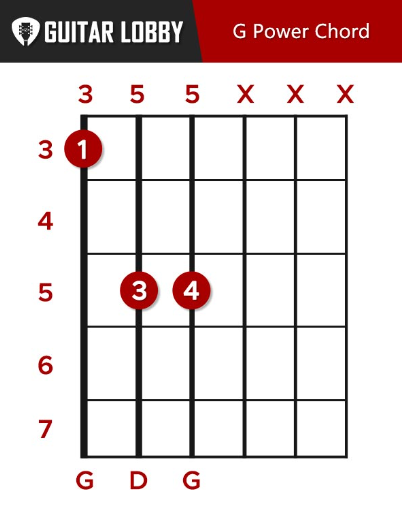
This diagram will help you visualize where to place your fingers on the fretboard for the G Power Chord.
Playing the G Power Chord
With your fingers in position, it’s time to play the G Power Chord. This section will guide you through the technique of playing the chord effectively.
Strumming the Chord
1. Strumming Technique
- Use either a pick or your thumb to strum the strings.
- Strum downwards across the 6th and 5th strings with a firm, controlled motion.
2. Consistent Rhythm
- Practice strumming in a steady rhythm. You can start slowly and gradually increase your speed as you become more comfortable.
HUGE Mistakes to Avoid
- Muting Strings: Ensure that your strumming hand does not accidentally mute the strings you are pressing. This can dampen the sound of the chord.
- Excessive Force: While it’s important to press firmly, using too much force can make the chord sound sharp and can cause hand fatigue.
Exercises to Practice the Chord Transition
1. Switching Between Chords
- Practice transitioning from the G Power Chord to other simple chords, like the E or A Power Chord.
- This helps build muscle memory and improves your chord transition speed.
2. Repetition
- Repeat the process of playing the G Power Chord, lifting your fingers off the fretboard, and then placing them back in position. This will enhance your muscle memory.
Building Muscle Memory
Consistent practice is key to mastering the G Power Chord. Spend time each day practicing the chord, focusing on clean finger placement and clear strumming. As your confidence grows, incorporate the G Power Chord into simple songs or chord progressions.
Applying the G Power Chord in Music
So many songs use the G Power Chord. Having learned how to play the G Power Chord and have your hand aching with pleasure, it’s time to understand how to apply it in actual music. This chord is a staple in various genres, notably in popular music and metal, where its powerful sound forms the basis of many iconic songs.
Examples of Songs Featuring the G Power Chord
1. Popular Music
- “When I Come Around” by Green Day: This song features a sequence of power chords, including G5, and is an excellent example of how power chords can drive a song’s rhythm.
- “Wild Thing” by The Troggs: A classic tune that uses a simple progression including the G Power Chord.
2. Metal Music
- “Enter Sandman” by Metallica: The intro riff of this song is a fantastic example of the G Power Chord’s role in creating a heavy, impactful sound.
- “Iron Man” by Black Sabbath: Another iconic riff that uses the G Power Chord to create its signature heavy metal sound.
Incorporating the G Power Chord into Different Music Styles
- Strumming Patterns: Experiment with different strumming patterns. In pop, a steady, rhythmic strum might be suitable, whereas in metal, a faster, more aggressive strumming technique is often used.
- Palm Muting: This technique, where the palm of your strumming hand lightly rests on the strings near the bridge, is prevalent in metal. It gives the G Power Chord a muted, chunky sound.
Practice Routines
- Song-Based Practice: Try to play along with the songs mentioned above. Start by playing only the G Power Chord parts and gradually try to play the entire chord progressions.
- Creating Your Own Riffs: Experiment with creating simple riffs using the G Power Chord. Play the chord, then add a single note or another power chord to create a two-bar riff.
Advanced Tips and Techniques
As you become comfortable with the G Power Chord, you can start exploring more advanced techniques to further enhance your playing.
More Stuff on the G Power Chord
- Adding Effects : Using guitar effects like distortion or overdrive can significantly change the sound of the G Power Chord, making it more suitable for genres like metal.
- Playing Variations: Try adding an octave above the fifth (D note) to the chord. This means pressing the 7th fret on the 4th (D) string along with the usual G Power Chord shape.
Transitioning to Other Chords Fluidly
- Practice Drills: Practice moving from the G Power Chord to other chords in quick succession. For example, move from G5 to C5 to D5 in a repetitive cycle.
- Speed and Precision Exercises: Use a metronome and start at a slow pace. Play the G Power Chord for four beats, then switch to another chord for four beats. Gradually increase the metronome speed as you get more comfortable.
Developing Speed and Precision
- Alternate Picking: When practicing riffs, use alternate picking (down-up strumming) to increase your picking speed.
- Finger Exercises: Regularly perform finger stretching and strengthening exercises to improve agility and reduce the risk of injury.
